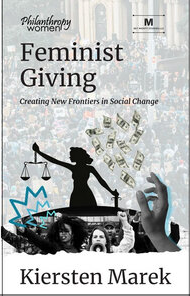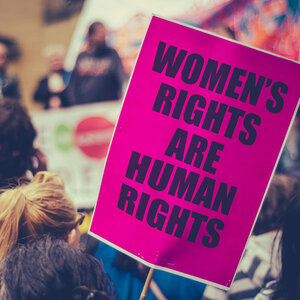Feminist Giving: Creating New Frontiers in Social Change
When we think about women’s philanthropy, we often think about it in the context of recent events centered around “rage giving”—givers reacting to a “polarizing” event or divisive political moment, with extensive media coverage eliciting a strong emotional response that fuels reactive giving in efforts to “right a wrong” and making their voices heard by putting dollars behind their views. Typically, rage givers donate in small sums.
The Women’s Philanthropy Institute’s research has found that women gave to progressive causes in record numbers after the election of Donald J. Trump, outpacing giving by men sixfold. Fast forward to 2022: The leak of the U.S. Supreme Court’s decision overturning Roe v. Wade led to another watershed moment for rage giving. This time the focus was on abortion funds, which have long been an underfunded part of the reproductive health world. Yet while rage giving clearly plays a role in women’s philanthropy, it is not the be-all and end-all of funding by and for women, which from its inception has been strategically rooted in bringing about change and equality.
In Feminist Giving: Creating New Frontiers in Social Change, author Kiersten Marek, founder and publisher of Philanthropy Women, discusses how there was a time in the not-too-distant past, in the early aughts, when there was a belief among funders that there was “quite enough” philanthropy out there for women’s rights and there wasn’t a need for more to be done, and funding for women, especially by U.S.-based donors, should be redirected globally. In addition, hot-button topics like reproductive rights and equal pay for women were seen as too political or risky even for women givers to commit to.
Marek regrets that women were put in the position of sacrificing those efforts that mattered to many women for fear of, as she calls it, the “social ramifications of their power” and expresses hope that our current political and social climate will elicit other choices. It’s interesting to note the waxing and waning of urgency about funding women’s causes based on dictates outside of women’s purview. One might raise the question of who gets to decide when funding for women is needed. And why isn’t it always women themselves?
Marek takes multiple deep dives into the various causes that mean the most to women and those who give to women’s causes. She doesn’t shy away from thorny topics or from shining a light on issues that have long been obscured in philanthropic discussions. In her writing and research, including for Philanthropy Women, she works to lift up voices that she feels need to be heard. Among them are leaders like LaTosha Brown, who heads the Southern Black Girls and Women’s Consortium. She positions Brown as someone at the forefront of the fight for equitable funding for BIPOC (Black, Indigenous, and people of color) women and girls alongside her work for voting rights. Marek discusses the urgent need for this funding and how the voices of Black women are important to the social discourse—which they are largely left out of despite the tremendous contribution Black women make to the political process, the working world, leadership, and progressive change. In the book, Marek provides a platform to discuss the need for more Black women in positions of power on corporate and nonprofit boards.
In effect, Marek believes that the boldest leaders in philanthropy are women, many of whom are women of color, who drive new policies and laws, and cultural change on issues like health care, child care, workforce development, and financial inclusion. Right now, in thinking of mega-donors like Melinda French Gates and MacKenzie Scott, and recalling leaders Marek mentions in the book, including Felecia Lucky, president of the Black Belt Community Foundation; Surina Khan, CEO of Women’s Foundation California; and Ana Oliveira, president and CEO of the New York Women’s Foundation, that reality is apparent. Marek discusses how the gender-giving lens should be both strategic and intersectional.
Marek believes that the boldest leaders in philanthropy are women, many of whom are women of color, who drive new policies and laws, and cultural change on issues like health care, child care, workforce development, and financial inclusion.
She also gives a detailed account of the history of women’s funding in the United States, traversing the years of the suffrage movement to individual figures like Madam C.J. Walker and wealthy white women (in a section awkwardly titled “And What About the White Women”) while discussing Gilded Age women like Louise Whitfield Carnegie, Abby Aldrich Rockefeller, Brooke Astor, and Gertrude Vanderbilt Whitney who were the primary developers of their family’s philanthropic activities. Though she discusses these women as foremothers to American philanthropy, she makes it clear that their legacy is only one part of women’s philanthropy story and spends most of the book discussing its evolution. While there are fewer female than male mega-donors, we can acknowledge that the women of the Gilded Age provided a foundation for modern billionaire women to strike out on their own, even if cautiously.
When Marek talks of feminism, it’s not just in the context of how women give or why, but it’s also about feminism’s potential to improve the planet as a whole. She discusses how impactful women are in spurring change and providing guidance and leadership, especially in crises. She believes that women are better equipped to make choices for the betterment of all from the top down. I’ll note that we haven’t seen this tested in the U.S. at the highest level of political office, so her belief remains untested here, but it would be interesting to see her theory’s outcome on America’s national stage.
Yet the feminist giving community, Marek laments, may not want to be public facing about their giving strategies and prefer to make their activities less visible—for fear of backlash or in hopes of avoiding being inundated with funding requests. One wonders how she feels now that Scott has launched a website detailing her giving and will allow nonprofits to apply to her “open call” process. A win, probably, based on her viewpoints in the book.
While Marek details the work being done to fund women’s equality, she also uses the book as a primer for those looking for organizations working on women’s causes. She discusses the funding gaps, highlights those organizations that are doing the work, and explains what funders can do to assist. She highlights initiatives and programs that she believes should be lifted up and the people working behind the scenes to make them happen. Is she being selective in this process? Yes. Does it make it easy for readers to learn more about the organizations she mentions? Yes.
[Marek] believes that “philanthropy that engages climate, racial, and gender justice at the same time is taking an intersectional approach” and that by doing so, “the work can have a powerful social impact on many different levels and help address equality, inclusiveness, and systems issues that impact everyone”
Marek takes on the challenge of discussing various social issues, their impact on women, and what’s being done in philanthropy to bolster their efforts. It is a wide-ranging undertaking; she tries to leave no stone unturned. She believes that “philanthropy that engages climate, racial, and gender justice at the same time is taking an intersectional approach” and that by doing so, “the work can have a powerful social impact on many different levels and help address equality, inclusiveness, and systems issues that impact everyone,” urging readers to recognize and digest the magnitude of needs in this space. They are significant. Marek attempts to help readers get their arms around the enormous needs by providing a “who’s who” in philanthropy, leadership, legislation, activism, finance, and politics and essentially creates a directory of funders and nonprofits on the ground.
Marek makes the point that the voices of women of color are ever present, span multiple areas of women’s causes, and are core to delivering messages of great concern for many underrepresented and marginalized communities. Nor do their ideas stop at philanthropy. Marek highlights discussions about dividing funding between philanthropy and gender lens investing, which some in the field say trumps philanthropy as it’s just as important, or more so, to invest in women-owned or -led businesses and more women in the financial sector on a larger scale.
As she makes clear throughout the book, Marek sees women as being flexible and able to multitask in their giving. She recounts the growing power of collective giving and, in circling back to the notion of rage giving, how giving collectively can empower women of various income levels. She also is careful to mention the role men have in feminist giving, quoting Giovanna Lauro, vice president of programs and research at Equimundo, who said that “continued female empowerment requires men and boys to see themselves as allies and partners, not adversaries” and “change is not a zero-sum game, and men and boys also gain when rigid attitudes toward gender are challenged.”
Marek’s tome showcases years of study on this topic, lifts up numerous voices, and discusses the nuances related to feminism and philanthropy while also presenting a handy guide for women’s giving. The book gathers her deep conversations with women whose impact in this space she feels is vital and provides a roadmap for those inclined to donate. At the same time, Marek says that there is much more work to do and discussions to be had about funding women’s causes. She doesn’t believe that philanthropy alone, even by mega-donors, can change the culture of putting men and money first—there needs to be a cultural shift. Root causes cannot be addressed solely with philanthropic dollars when the rights of women and their health and safety still are subject to cultural values centering and protecting the (mostly white) men.
Feminist Giving: Creating New Frontiers in Social Change succeeds in its mission to uplift women, especially those of color, and provides a vehicle for presenting new ideas and challenging old ones. Marek does double duty as champion and witness, bringing years of research to bear, with an eye toward change by prioritizing women’s rights and needs in every facet of life.
Lauren Brathwaite is content editor at Philanthropy News Digest.









